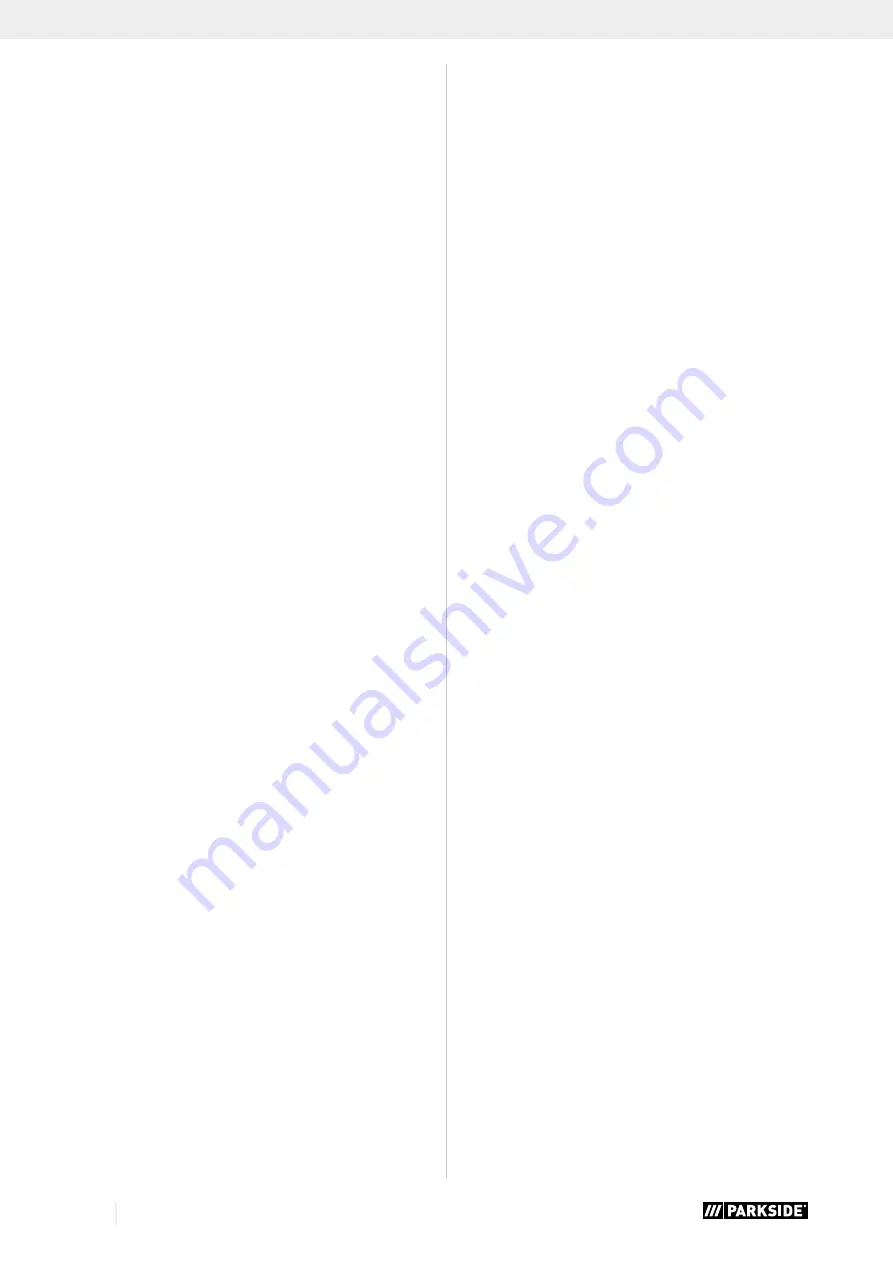
6
GB/IE
• Wear safety goggles and a respirator when working with
the compressed air pistol. Dusts are harmful to health! In-
juries can be easily caused by foreign objects and blown
away parts.
• Do not blow at people with the blow-out pistol and do not
clean clothes while being worn. Danger of injury!
Safety warnings when using spraying attach-
ments (e. g. paint sprayers)
• Keep the spray attachment away from the compressor when
filling so that no liquid comes into contact with the compressor.
• Never spray in the direction of the compressor when using
the spraying attachments (e.g. paint sprayers). Moisture can
lead to electrical hazards!
•
Do not process any paints or solvents with a flash point be-
low 55 °C. Risk of explosion!
• Do not heat up paints or solvents. Risk of explosion!
• If hazardous liquids are processed, wear protective filter
units (face guards). Also, adhere to the safety information
provided by the manufacturers of such liquids.
• The details and designations of the Ordinance on Hazard-
ous Substances, which are displayed on the outer packaging
of the processed material, must be observed. Additional pro-
tective measures are to be undertaken if necessary, particu-
larly the wearing of suitable clothing and masks.
• Do not smoke during the spraying process and/or in the
work area. Risk of explosion! Paint vapours are easily com-
bustible.
• Never set up or operate the equipment in the vicinity of a fire
place, open lights or sparking machines.
• Do not store or eat food and drink in the work area. Paint
vapours are harmful to your health.
• The work area must exceed 30 m³ and sufficient ventilation
must be ensured during spraying and drying.
• Do not spray against the wind. Always adhere to the regula-
tions of the local police authority when spraying combustible
or hazardous materials.
• Do not process media such as white spirit, butyl alcohol and
methylene chloride with the PVC pressure hose. These media
will destroy the pressure hose.
• The work area must be separated from the compressor so that
it cannot come into direct contact with the working medium.
Operation of pressure vessels
• Anyone who operates a pressure vessel must keep this in
good working order, operate and monitor it correctly, per-
form the necessary maintenance and servicing works imme-
diately and implement safety measures as required accord-
ing to the circumstances.
• The regulatory authority can instruct necessary monitoring
measures in individual cases.
• A pressure vessel must not be operated if it exhibits a defect
that poses a danger to personnel or third parties.
• Check the pressure vessel for rust and damage each time
before use. The compressor shall not be operated if the pres-
sure vessel is damaged or rusty. If you discover damage,
please contact the customer service workshop.
Keep these safety instructions in a safe place.
Residual risks
Comply with the stipulated maintenance and safety instructions
in the operating instructions.
Remain attentive at all times when working, and keep third par-
ties at a safe distance from your work area.
Even when the device is being used properly, there will always
be certain residual hazards that cannot be completely ruled
out. The following potential hazards can arise due to the type
and design of the device:
• Unintentional starting up of the product.
• Damage to hearing if the stipulated hearing protection is not
worn.
• Dirt particles, dust etc. can get irritate the eyes or face de-
spite wearing safety goggles.
• Inhaling swirled up particles.
Warning!
This power tool generates an electromagnetic field during op-
eration. This field can impair active or passive medical implants
under certain conditions. In order to prevent the risk of serious
or deadly injuries, we recommend that persons with medical
implants consult with their physician and the manufacturer of
the medical implant prior to operating the power tool.
7. Technical data
Mains connection ................................................ 230 V∼ 50 Hz
Motor power ..................................................................1500 W
Operating mode .......................................................................S1
Compressor speed .....................................................2850 min
-1
Pressure vessel capacity ..........................................approx. 24 l
Operating pressure ............................................... approx. 8 bar
Theo. intake capacity .................................... approx. 257 l/min
Effective delivery quantity at 7 bar .................approx. 80 l/min
Effective delivery quantity at 4 bar .............. approx. 110 l/min
Effective delivery quantity at 1 bar .............. approx. 150 l/min
Sound pressure level L
PA
...............................................68 dB(A)
Sound power level L
WA
..................................................86 dB(A)
Uncertainty K
PA
/
WA
..........................................................2.19 dB
Protection category ...............................................................IP30
Device weight ....................................................approx. 24.8 kg
Max. altitude (above mean sea level) ...........................1000 m
The noise emission values have been determined in accord-
ance with EN ISO 3744:1995.
Wear hearing protection.
Excessive noise can result in a loss of hearing.
8. Before commissioning
• Open the packaging and carefully remove the device.
• Remove the packaging material, packaging and transport
safety devices (if applicable).
• Check that the delivery is complete.
• Check the device and accessory parts for transport damage.
• If possible, keep the packaging until the end of the warranty
period.
Summary of Contents for 373211 2104
Page 3: ...2 15 10 13 6 12 11 5 16 4 7a 7 14 3 5 5b 5a 1 1 7 6 5 8 2 3 4 14b 14a 14 13 12 9 10 11 ...
Page 4: ...6 4d 4 8 4a 4c 4d 7 9 9c 9a 9b 8 9 4a 4b 4c 4d 10 A ...
Page 105: ......
Page 106: ......
Page 107: ......











































